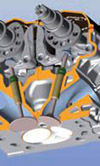Desmodromic
 Recently, RET has covered valve spring design and measurement extensively, but it is almost impossible to discuss valve spring design without mentioning the desmodromic system which is used nowadays exclusively by Ducati.The term Desmodromic is coined from the Greek words ‘desmos’, which means ‘controlled’, or ‘linked’, and ‘dromos’, which means ‘course’, or ‘track’. In modern engineering terms desmodromic refers to a mechanism which has different controls for its actuation in different directions.In modern times, Mercedes used the system on their W196 Formula One car of 1954-55, and then in 1956 Ducati took the system up and have never looked back since.The desmodromic system is famed for the fact that it eliminates the valve return spring and indeed in racing applications it does. But what every Ducati owner and mechanic knows is that roadgoing Ducati’s do feature valve return springs, just not conventional ones.There are two major issues which a production bike faces which do not apply to racing bikes; that is, starting and emissions.Whilst racing bikes are started via motored rollers which act on the rear tyre, production bikes rely on a starter motor. The starter motor can only start the engine promptly if the engine achieves sufficient compression and to ensure that this is the case, small torsional helper springs act on the closing cams of both the inlet and exhaust valves to hold the valves closed.If these springs are omitted, the clearances in the closing mechanism, which must be built in to allow for component wear and differential thermal expansion, will mean the valve stays too far open (when it should be seated) to allow starting.
Recently, RET has covered valve spring design and measurement extensively, but it is almost impossible to discuss valve spring design without mentioning the desmodromic system which is used nowadays exclusively by Ducati.The term Desmodromic is coined from the Greek words ‘desmos’, which means ‘controlled’, or ‘linked’, and ‘dromos’, which means ‘course’, or ‘track’. In modern engineering terms desmodromic refers to a mechanism which has different controls for its actuation in different directions.In modern times, Mercedes used the system on their W196 Formula One car of 1954-55, and then in 1956 Ducati took the system up and have never looked back since.The desmodromic system is famed for the fact that it eliminates the valve return spring and indeed in racing applications it does. But what every Ducati owner and mechanic knows is that roadgoing Ducati’s do feature valve return springs, just not conventional ones.There are two major issues which a production bike faces which do not apply to racing bikes; that is, starting and emissions.Whilst racing bikes are started via motored rollers which act on the rear tyre, production bikes rely on a starter motor. The starter motor can only start the engine promptly if the engine achieves sufficient compression and to ensure that this is the case, small torsional helper springs act on the closing cams of both the inlet and exhaust valves to hold the valves closed.If these springs are omitted, the clearances in the closing mechanism, which must be built in to allow for component wear and differential thermal expansion, will mean the valve stays too far open (when it should be seated) to allow starting.
The other major issue which is addressed by the torsional helper springs, is emissions. On a production bike if the valves are not held shut then unburnt fuel can pass into the exhaust system which is not just harmful to the emissions themselves but also dangerous for the catalytic converter. In the modern climate of European, and indeed worldwide emissions legislation, this is a serious consideration for a manufacturer.Smaller, but never the less important issues addressed by the torsional helper springs are idling and noise. A desmodromic equipped engine will idle more smoothly and run more quietly – probably the first time the words idle and quietly have been used in a sentence concerning Ducati’s for a while – with the helper springs installed.Torsional (or hairspring) springs can be used as valve return springs themselves, and were originally used as such on Manx Norton engines of the 1950s as a method of eliminating valve spring surge. Ducati helper springs are a different matter and are used only in addition to the closing cam, to close the valve once it is near to its seat.So it turns out that holding the valve closed on its seat is almost an un-assumed advantage of using a conventional valve return spring to shut a poppet valve; and one that must be considered even in a nominally springless system.